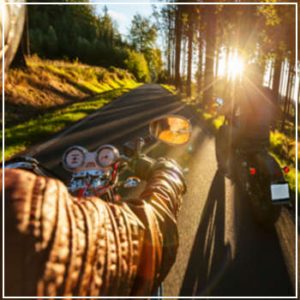
The conditions we ride through during spring, summer and early fall increase the chances of dehydration. Especially when you’re wearing a heavy leather riding jacket, the direct sun beats down on you and the whipping winds can leave you feeling dried out.
You may initially feel thirsty, but symptoms can develop into headache, nausea and muscle cramps. To avoid these first signs of heat stroke, have an effective hydration plan for your upcoming rides.
Before You Go Out
Preventing dehydration starts with preparation. The night before a big ride, lower your alcohol and caffeine intake – too much has a diuretic effect on the body, causing you to release more water than you take in.
The day of your ride, start drinking water in the morning and continue gradually throughout the day. Drinking too much at once may lead to stomach cramps. Also realize that while water and other fluids quench your thirst immediately, they take roughly an hour to reach your muscles.
Use a Hydration Pack
Hikers and cyclists swear by hydration packs. For longer rides, they are growing in popularity among motorcycle riders. The convenient two-in-one design combines a 1.5L to 3L bladder with a tube and bite valve that let you drink hands-free, and an actual bag for storing a few small items. All you have to do is strap it on, sip and refill at the next rest stop.
Beyond the convenience factor, it’s far safer than using a mug or water bottle to stay hydrated and usually holds more fluid. To keep your water cold, consider filling and freezing the bladder the night before your trip.
Be Careful When You Stop
Sugary snacks and caffeinated beverages may counteract the hydrating effect of water. As such, make conscious choices when you stop for something to eat: Avoid cakes and donuts, limit your caffeinated beverage intake and avoid over-sweetening with sugar. More water, low-sugar juices and protein-packed foods help you keep on going.
It’s important to stop every 100 to 150 miles to refuel and stretch your legs to avoid cramping. If you’ve been in direct sun for several hours, look for a spot in the shade or in an air-conditioned space to cool down and refill your water bottle.
Dress for Hot Weather
You may be tempted on a warm day, but a tank top, shorts and sandals are not safe riding attire. Rather, try to keep yourself cool with these tips:
- Wear ventilated clothing. Leather by itself traps heat, causing you to sweat more. Instead, have a mesh or vented leather jacket on-hand.
- As you ride, loosen your sleeves and wrist cuffs to keep your blood flowing and the air circulating.
How do you manage dehydration when you’re out on your bike? Share your best tips on our Facebook page.
